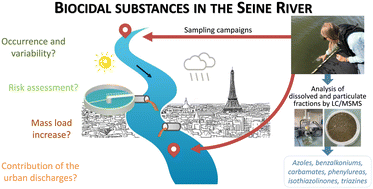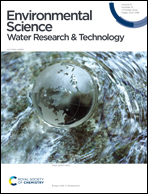Biocidal substances in the Seine River: contribution from urban sources in the Paris megacity†
Abstract
This work addresses river contamination by biocidal substances up- and downstream a megacity, with the aim of investigating the contribution of urban discharges and proposing effective and concerted mitigation solutions. To this end, ten campaigns were conducted in the two main rivers of the Paris conurbation. Eighteen previously prioritized biocides were all quantified at three sampling locations, and several were found at concentrations that may present a risk to the aquatic ecosystem (dichloroisothiazolinone, diuron, and benzalkonium C12 and C14, with concentrations up to 42, 75, 1700, and 150 ng L−1, respectively). The collected data enabled the assessment of daily mass loads of biocides (from <1 g per day to several tens of kg per day, the highest values observed being for benzalkonium C12 and C14) which were put into perspective with previously characterized loads from major urban sources. A shift in the distribution of biocide loads between up- and downstream the Paris conurbation was observed for several molecules (benzisothiazolinone, terbutryn, and thiabendazole, the median load of which increased by a factor of 1.5 to 3), thus suggesting the contribution of urban discharges to the contamination of receiving waters by biocides. Analysing the long-term dynamics of biocides in the Seine River showed that even if the ban of several molecules as pesticides did have a noticeable impact on surface water contamination, a background pollution remained (3 < diuron < 75 ng L−1; 0.1 < isoproturon < 5.7 ng L−1), which may be related to urban inputs. Our results offer prospects for specific mitigation solutions at three scales: emissions, transport in the sewer system and treatment before discharge.



 Please wait while we load your content...
Please wait while we load your content...